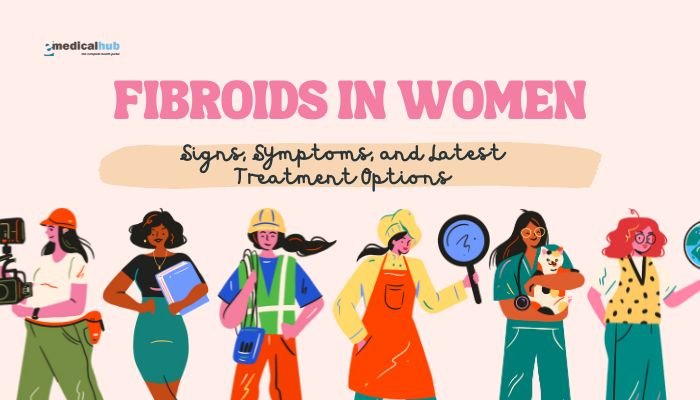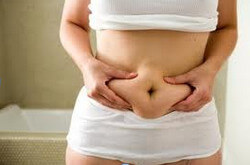Introduction
Fibroids are growths in the uterus. They are also called uterine leiomyomas or myomas. These tumors are not cancer. They come from muscle and connective tissue. Many women have fibroids, especially in their 30s or 40s.
Some have no issues, while others can face bleeding, pain, or fertility problems. The size and number of fibroids vary. They can be as small as seeds or as large as grapefruit, and they can grow in different parts of the uterus.
This article talks about the signs and symptoms of fibroids, how doctors diagnose them, treatment methods, and how lifestyle changes may help. It also shows the latest treatment trends. By learning these facts, women with fibroids can make better decisions and get proper medical help.
Understanding Uterine Fibroids
What Are Fibroids?
- Fibroids are muscle growths in the uterus.
- They are generally not cancer.
- They come in different forms, shapes, and sizes.
Quote: “Fibroids often appear in adulthood and might shrink after menopause due to lower hormone levels.”
Types of Fibroids
- Intramural Fibroids
- These fibroids grow within the wall of the uterus.
- They are among the most common fibroids.
- They can enlarge the uterus if they become big.
- Subserosal Fibroids
- These form on the outer surface of the uterus.
- Large subserosal fibroids can press on nearby organs.
- They might extend on stalks, sometimes called pedunculated fibroids.
- Submucosal Fibroid
- These develop under the inner lining of the uterine cavity.
- They can cause heavy bleeding.
- Even small ones can create big symptoms.
- Pedunculated Fibroids
- These fibroids develop on stalk-like structures.
- They can grow inside or outside the uterus.
- Twisting of the stalk may cause intense pain.
Risk Factors
- Family History: If the mother or sister had fibroids, risk can be higher.
- Age: Many are found in the 30s or 40s. They might shrink after menopause.
- Ethnicity: African American women have a higher chance and may face more severe symptoms.
- Hormones: Estrogen and progesterone can stimulate fibroid growth.
- Obesity: Excess body weight can raise hormone levels, increasing risk.
- Diet: High intake of red meat and low consumption of fruits/vegetables may raise risk.
Signs and Symptoms
Heavy Menstrual Bleeding
- Some women have periods so heavy that they must change pads or tampons often.
- This can lead to anemia, marked by tiredness and dizziness.
Pelvic Pain or Pressure
- Large fibroids can cause a sensation of fullness in the lower abdomen.
- Pain might feel dull or sharp, depending on fibroid location.
Long Menstrual Periods
- Bleeding may extend for more than a week.
- Some women have spotting in between cycles.
Frequent Urination or Constipation
- A big fibroid can press the bladder or rectum.
- This causes urinary frequency or difficulty passing stool.
Painful Intercourse
- Fibroids close to the cervix or uterus lining can lead to discomfort during intercourse.
- Emotional distress can accompany this symptom.
Lower Back or Leg Pain
- If fibroids press on nerves in the lower back, pain may spread to the legs.
- This occurs with fibroids in specific pelvic regions.
Infertility or Miscarriage
- Although many conceive without problems, fibroids can sometimes affect fertility.
- Submucosal types, in particular, might disrupt the uterine lining.
Key Point: Some women have no notable symptoms. Routine pelvic exams or imaging may detect fibroids by chance.
Diagnosis of Fibroids
Medical History and Physical Exam
- Symptom Review: A doctor asks about menstrual history, pain, and family background.
- Pelvic Exam: They check for an enlarged uterus or abnormal lumps.
Imaging Studies
- Ultrasound
- A primary imaging test for fibroids.
- Transvaginal ultrasound provides clearer details.
- Shows fibroid size, number, and position.
- MRI (Magnetic Resonance Imaging)
- More detailed than ultrasound.
- Helpful for large or multiple fibroids.
- Guides treatment decisions or pre-surgical planning.
- Saline Infusion Sonography (SIS)
- A small amount of fluid is placed in the uterus.
- Improves the view of the uterine cavity on ultrasound.
- Useful for spotting submucosal fibroids.
- Hysterosalpingography (HSG)
- Dye is introduced into the uterus for X-ray imaging.
- Used more for fertility checks, but can show changes in uterine shape.
Other Tests
- Lab Tests: Blood checks might see if there is anemia.
- Endometrial Biopsy: If there is suspicious bleeding, a sample may rule out other conditions.
Key Point: Proper imaging and exam confirm if symptoms stem from fibroids or from other causes like polyps or adenomyosis.
Factors Influencing Treatment
- Symptom Severity: The level of bleeding, pain, and life impact.
- Fibroid Size and Location: Submucosal fibroids often cause heavy bleeding, while subserosal can cause pelvic pressure.
- Reproductive Goals: A woman wanting future pregnancy may prefer fertility-sparing methods.
- Overall Health: Medical conditions like anemia may accelerate the need for therapy.
- Patient Preference: Each approach has pros and cons. Patient comfort is essential.
Treatment Options
Watchful Waiting
- Mild or No Symptoms: If fibroids are small and stable, doctors may just monitor.
- Regular Exams: Periodic check-ups track any changes in fibroid size or new symptoms.
- Lifestyle Steps: A healthy diet and exercise may reduce fibroid growth in some cases.
Medication Approaches
- Nonsteroidal Anti-Inflammatory Drugs (NSAIDs)
- For pain relief.
- Do not shrink fibroids but reduce discomfort during menstruation.
- Hormonal Birth Control
- Pills, patches, rings can help control heavy bleeding.
- May not significantly reduce fibroid size.
- Submucosal fibroids might respond better to local interventions.
- Progestin-Releasing Intrauterine Device (IUD)
- Releases hormones into the uterus to reduce bleeding.
- Does not shrink fibroids but can ease symptoms.
- GnRH Agonists (e.g., Leuprolide)
- Temporarily block estrogen and progesterone.
- Often used before surgery to shrink fibroids.
- Long-term use can cause menopausal-like effects and bone density loss.
- GnRH Antagonists
- Similar aim as GnRH agonists but can have fewer side effects.
- Used to shrink fibroids or reduce bleeding pre-surgery.
- Selective Progesterone Receptor Modulators (SPRMs)
- Can halt fibroid growth and reduce heavy periods.
- Monitored for side effects on the uterine lining.
Uterine-Artery Embolization (UAE)
- What It Is: A minimally invasive approach. Radiologists use a catheter in the groin or wrist to target blood vessels feeding the fibroids. Tiny particles block these vessels.
- Fibroid Response: The fibroids shrink due to reduced blood supply.
- Recovery: Shorter hospital stay compared to major surgery.
- Risks: Mild post-procedure pain, and potential impact on future fertility is still uncertain.
High-Intensity Focused Ultrasound (HIFU)
- Technique: Sound waves are focused on the fibroid to heat and destroy tissue.
- Guidance: MRI helps direct the energy.
- Pros: No incisions. Quick recovery.
- Limitations: Not for large or many fibroids, or if fibroids are behind bone or bowel.
Surgical Options
Myomectomy
- Definition: Surgical fibroid removal while keeping the uterus.
- Ideal For: Women who plan future pregnancies.
- Approaches: Hysteroscopic (through the cervix), laparoscopic (small abdominal incisions), or open surgery (larger cut).
- Outcomes: Symptom relief with uterus preservation. However, fibroids can recur.
Hysterectomy
- Definition: Removal of the uterus.
- Permanent Solution: No further periods or fibroid regrowth.
- Who Chooses This: Those done with childbearing, or severe cases where other methods fail.
- Types: Can be total (removal of uterus and cervix) or partial (leaving the cervix). Ovaries may or may not be removed.
Endometrial Ablation
- Process: Destroys the uterine lining using heat or other methods.
- Target: Helps reduce heavy menstrual bleeding.
- Limit: Not ideal for large fibroids or those wanting future fertility.
Complementary and Alternative Steps
- Herbal Supplements: Some choose herbs for symptom relief. Evidence is limited.
- Diet Changes: More fruits, vegetables, whole grains, and less red meat or processed food.
- Stress Management: Yoga, meditation, or counseling to ease pain perception.
- Acupuncture: Some report less pain, though data are mixed.
Quote: “Modern medicine offers several ways to manage fibroids, from minor symptom control to definitive procedures.”
Latest Advancements and Trends
Radiofrequency Ablation (RFA)
- Method: Uses heat to destroy fibroid cells.
- Minimally Invasive: Done laparoscopically or transcervically.
- Recovery: Often quick, with minimal scarring.
Laparoscopic Ultrasound-Guided Techniques
- Precision: Surgeons see real-time imaging of fibroids.
- Targeted Removal: This approach can preserve healthy uterine tissue.
MRI-Guided Interventions
- Refined HIFU: Improved imaging allows better targeting and safety.
- Future Research: Researchers aim to treat more fibroid types this way.
Genetic and Molecular Research
- Goal: Learn how fibroids form and find targeted drugs.
- Hope: Treatments that shrink fibroids without major side effects.
Personalized Medicine
- Hormone Profiling: Adjust treatments to each woman’s hormonal status.
- Patient-Centered Care: Respecting fertility wishes, symptom severity, and personal choice in selecting therapy.
Lifestyle and Self-Help Measures
Balanced Diet
- Leafy Greens, Fruits, Whole Grains: Provide vitamins, minerals, antioxidants.
- Low-Fat Dairy: For calcium and vitamin D (bone health).
- Limit Salt and Sugar: Reduces bloating and metabolic stress.
Maintain Healthy Weight
- Hormones: Excess body fat can boost estrogen.
- Modest Weight Loss: Even 5–10% weight reduction can help with symptoms.
Regular Exercise
- Aerobic Activities: Brisk walking, biking, or swimming.
- Strength Training: Helps metabolism and body composition.
- Stress Relief: Physical activity can lower pain perception.
Stress Control
- Relaxation Techniques: Deep breathing, meditation, or yoga.
- Counseling: Chronic pain or heavy bleeding can lead to anxiety or depression. Therapy can help.
- Sleep: Adequate rest supports hormone balance.
Tracking Symptoms
- Menstrual Diary: Note flow, clots, and pain severity.
- Medication Effects: Log how you feel after starting or stopping a treatment.
- Regular Check-ups: Catch changes in fibroid size or new symptoms early.
Potential Complications
Severe Anemia
Heavy bleeding leads to low iron levels. Symptoms include fatigue, dizziness, and pale skin.
Urinary Issues
Big fibroids pressing on the bladder can cause frequent urges to go or trouble fully emptying.
Fertility Concerns
Some fibroids can distort the uterine cavity or block fallopian tubes. This may hinder conception or raise miscarriage risk. But not all fibroids affect fertility.
Impact on Pregnancy
- Preterm Delivery: If fibroids grow during pregnancy.
- Breech Position: Babies might not settle into the normal head-down position.
- Delivery Complications: Sometimes fibroids limit vaginal delivery, so a cesarean section may be needed.
Key Point: Early detection and treatment can reduce these risks.
Questions to Ask Your Doctor
- Which fibroid type do I have, and how big is it?
- Are my symptoms likely caused by fibroids, or could something else be involved?
- What are my treatment choices, and which do you think is best for my case?
- How will each treatment option affect my fertility?
- What are possible side effects or complications?
- How quickly should I decide on treatment?
- Will the fibroids come back after treatment?
- Are there lifestyle or diet changes I can make to help reduce symptoms?
Living with Fibroids
Emotional Well-Being
- Chronic bleeding or pain can sap energy.
- Seek counseling or join support groups if you feel overwhelmed.
- Family or friends might not realize how serious fibroid symptoms can be, so share details to get needed support.
Workplace Adjustments
- Plan for sick days or heavier bleeding days.
- Keep pain relief supplies on hand.
- Talk with managers if you need flexible scheduling or quick restroom access.
Family Planning and Partnerships
- If pregnancy is a goal, plan in advance.
- Partners often worry about a loved one’s health. Honest communication helps them understand the condition.
- Myomectomy or other fertility-preserving treatments can improve chances of conceiving if fibroids impede pregnancy.
Self-Advocacy
- Track symptoms thoroughly.
- Get second opinions if unsure about a recommended procedure.
- Stay updated on new treatments or clinical trials, especially if standard care is not working well.
Comparison of Main Treatment Methods (Table)
| Treatment | Key Features | Pros | Cons |
| Watchful Waiting | Observation if symptoms are mild | No side effects, no downtime | Fibroids may keep growing, must track changes |
| Medical Therapy | Hormone-based treatments like GnRH agonists, pills, IUD | Can shrink fibroids or reduce bleeding | Possible side effects (e.g., hot flashes, mood changes) |
| Uterine Artery Embolization | Blocking fibroid blood supply | Minimally invasive, shorter recovery | Fertility impact uncertain, not for all fibroid locations |
| High-Intensity Focused Ultrasound (HIFU) | Noninvasive destruction of fibroids via sound waves | Quick recovery, no incisions | Not suitable for all fibroids, might need specialized centers |
| Myomectomy | Surgical removal of fibroids, uterus left intact | Good for those wanting future pregnancy | Possible recurrence, recovery depends on surgical method |
| Hysterectomy | Removal of uterus (and possibly ovaries) | Definitive solution for fibroids | No future pregnancy, major surgery, potential hormone changes |
Looking Ahead: Research and Hope
- Gene Studies: Scientists probe genetic factors linked to fibroids, hoping for drugs that block growth at the root.
- Targeted Medications: Ongoing research tests new hormone-blocking agents or immune-based therapies.
- Less Invasive Solutions: Tools like advanced MRI-guided HIFU or improved laparoscopic instruments bring more precision.
- Patient-Centered Care: Strong emphasis is placed on personal preferences, symptom severity, and fertility wishes.
Key Point: The fibroid treatment field evolves steadily, with better outcomes and fewer side effects as technology advances.
Conclusion
Fibroids are non-cancerous growths in the uterus that may cause heavy bleeding, pain, or pressure symptoms. Some produce mild effects, while others significantly disrupt a woman’s health and daily life. Diagnosing fibroids often starts with a pelvic exam and imaging, with surgery offering a definitive view. Treatment decisions hinge on symptom severity, fibroid size, fertility desires, and a patient’s preferences. Options range from watchful waiting to medications, uterine artery embolization, and various surgeries. Newer, less invasive treatments, including high-intensity focused ultrasound and radiofrequency ablation, are expanding choices for many women.
Lifestyle factors—like a balanced diet, exercise, and stress management—might also support symptom control, though they typically do not remove fibroids entirely. If you suspect fibroids, track your symptoms and seek medical guidance early. Many solutions exist to manage or remove fibroids while safeguarding overall health and fertility plans. Ongoing research aims to refine treatments further and reduce risks, offering hope to those living with fibroids.
References
- Stewart EA. Uterine fibroids. Lancet. 2015; 386(9992): 293-302.
- Bulun SE. Uterine fibroids. N Engl J Med. 2013; 369(14): 1344-1355.
- Baird DD, Dunson DB, Hill MC, et al. High cumulative incidence of uterine leiomyoma in black and white women. Am J Obstet Gynecol. 2003; 188(1): 100-107.
- Pritts EA, Parker WH, Olive DL. Fibroids and infertility: an updated systematic review of the evidence. Fertil Steril. 2009; 91(4): 1215-1223.
- Wallach EE, Vlahos NF. Uterine myomas: an overview of development, clinical features, and management. Obstet Gynecol. 2004; 104(1): 393-406.
- Donnez J, Dolmans MM. Uterine fibroid management: from the present to the future. Hum Reprod Update. 2016; 22(6): 665-686.
- De La Cruz MS, Buchanan EM. Uterine fibroids: diagnosis and treatment. Am Fam Physician. 2017; 95(2): 100-107.
- Laughlin-Tommaso SK, Hesley GK, Hopkins MR, et al. Clinical outcomes of focused ultrasound surgery for fibroids: a review. Curr Opin Obstet Gynecol. 2016; 28(4): 304-311.
- Taran FA, Stewart EA, Brucker S. Current and future treatment strategies for uterine fibroids. Expert Opin Pharmacother. 2019; 20(9): 1109-1122.
- McLucas B. Diagnosis, imaging, and anatomy of fibroids. Best Pract Res Clin Obstet Gynaecol. 2018; 46: 3-11.
- Isaacson K, Berman JM. Clinical manifestations and diagnosis of uterine myomas. Semin Reprod Med. 2010; 28(3): 163-166.
- Lumsden MA, Hamoodi I, Gupta J, et al. Fibroids: Diagnosis and management. BMJ. 2015; 351: h4887.
- Jacoby VL, Kohlman RL. Clinical management of uterine fibroids. Obstet Gynecol Clin North Am. 2020; 47(1): 97-112.
- Davis MR, Soliman AM, Castelli-Haley J, et al. Treatments, patterns, and outcomes of uterine fibroids. Am J Obstet Gynecol. 2020; 223(6): 779-780.




